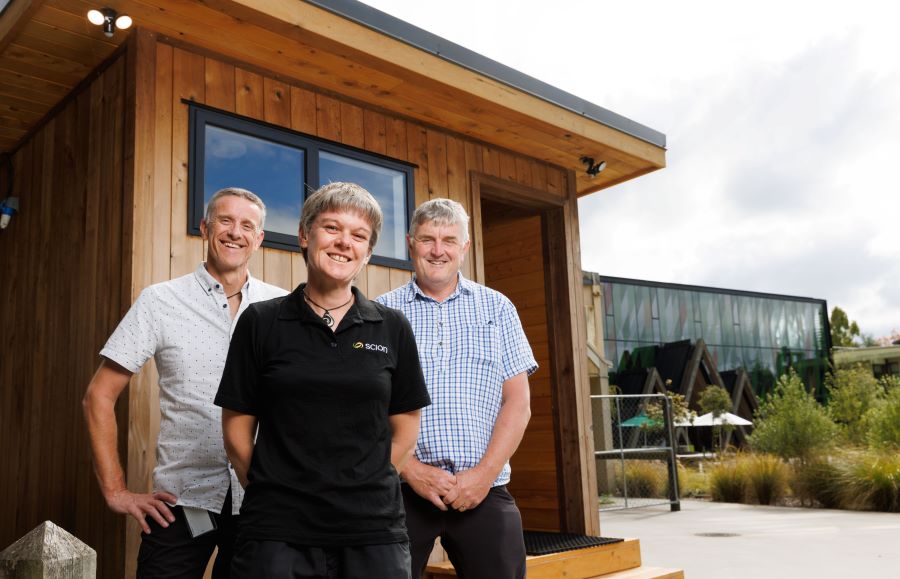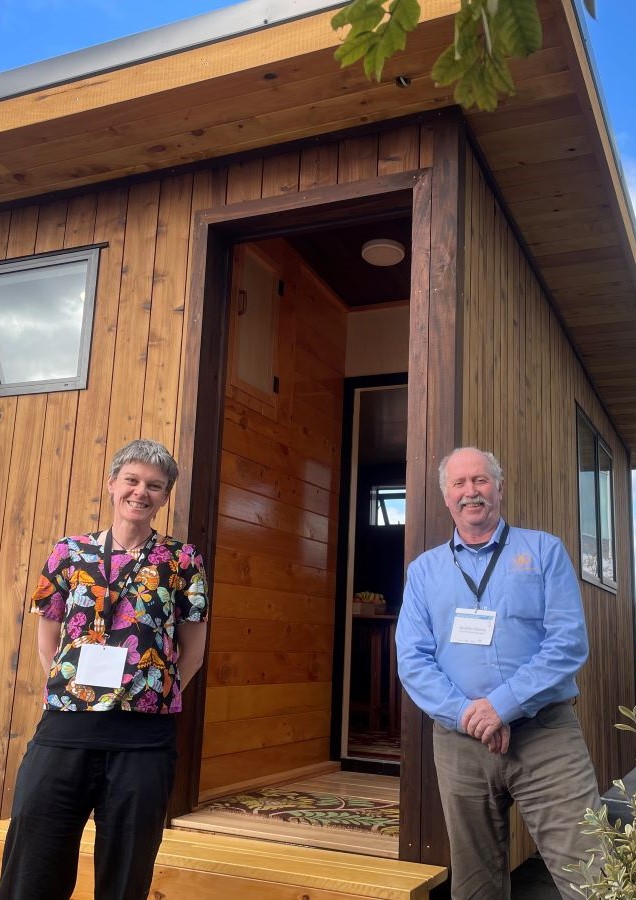Cabin showcases diverse, locally grown timbers
This two-room cabin demonstrates the building potential of local timbers.
With parts constructed from four cypress species, eucalyptus flooring, poplar plywood ceiling linings and Douglas-fir roof framing, the Specialty Wood Species Cabin might look like a collection of disparate timbers, but it’s that way for a reason.
The cabin showcases what can be done with alternative timbers and without using chemicals. It came about following the seven year Specialty Wood Products Research Partnership (SWP).
The SWP investigated new wood products derived from specialty species. It aimed to increase the productivity and profitability of specialty species and develop a high value specialty wood products industry.

It focussed on the three New Zealand-grown, leading alternatives to radiata pine – Douglas-fir, cypresses and eucalypts.
The government and industry-funded SWP research project ran from 2015 to 2022 and included representatives from Forest Growers Research, Te Uru Rākau – New Zealand Forest Service, the Ministry for Primary Industries, Scion, New Zealand Farm Forestry Association, NZ Dryland Forests Innovation and University of Canterbury. Scion was a key research provider.
Vaughan Kearns of Ruapehu Sawmills had been heavily involved in the SWP project and when it finished, he wanted to find a way to showcase the thermally modified cypress created during the project.
The cabin itself aims to challenge the durability of thermally modified cypress in a real-world environment rather than just the research environment where durability testing is ongoing.
“It was an opportunity to showcase the other products that came out of the SWP such as the eucalyptus laminated veneer lumber (LVL) and eucalyptus engineered flooring. On the back of that there was the opportunity to showcase the timbers that Ruapehu Sawmills produces such as some cypresses,” Kearns says.
The building was roughly half funded by Ruapehu Sawmills with contributions from SWP partners and the Industry Transformation Plan.

Working with nature
The cabin, roughly 5m by 3.5m is currently housed on Scion’s Rotorua campus for the public to view. Along with strategically placed double-glazed windows, it is designed to be oriented to make the most of the sun’s natural light and heat.
The timbers used in construction were supplied from trees grownin New Zealand and the only treated timber used in the build is the skids in contact with the ground. The rest of the wood is either naturally durable or thermally modified (baked at high temperatures to remove sugars and increase durability and stability) showing you can build without added chemicals and still meet building code requirements.
Wood used in the build includes Grand fir, Douglas-fir, Western red cedar, poplar plywood, Eucalyptus fastigata and Eucalyptus obliqua and four cypress species of macrocarpa, lusitanica, Cupressus x Nootkatensis and Chamaecyparis lawsoniana (Lawson cypress).
Some of the cypress used was from a cypress hybrid trial established by Scion in 1997, meaning Scion has been able to track the trees from cuttings, through to finished products.
Scion’s work researching naturally durable or thermally modified wood is longstanding with recent research focussing on thermally modifying tōtara to enhance its durability enough for exterior building uses.
Senior technologist Rosie Sargent says it is great for people to be able to see the types of products that can be made from these species, and the cabin provides an opportunity to learn how these products perform in real life situations.
Trees to High Value Wood Products interim portfolio leader Elizabeth Dunningham says the cabin will provide useful data about product performance as Scion staff make ongoing assessments.
The cabin is made up of a range of wood and wood products including Eucalyptus obliqua flooring and a thermally modified cypress feature wall.
“A wide range of collaborators contributed years of hard work and key technical know-how into the SWP, so it’s great the cabin is at Scion to showcase some of the products from that important collaboration.”
Marco Lausberg, Forest Growers Research’s SWP programme manager, says the cabin was a talking point when on display at last year’s FGR annual conference and there could be a growing market for these products.
“There’s a different consumer that is happy to pay more for less of an environmental impact. There is interest and demand for non-treated products.”
Specialty wood research continues
The SWP had a $14 million budget made of annual contributions of $710,000 from industry, $710,000 from MBIE and also had annual aligned funding of $550,000 from Scion.
It was driven by reducing sectoral risk, creating products for new markets and spurring regional development.
As a key research provider for the SWP partnership, Scion led the research into many of the products featured in the cabin. In some cases, research is ongoing, and the cabin will provide data about product performance in service over time as Scion staff make assessments of the cabin’s different components.
